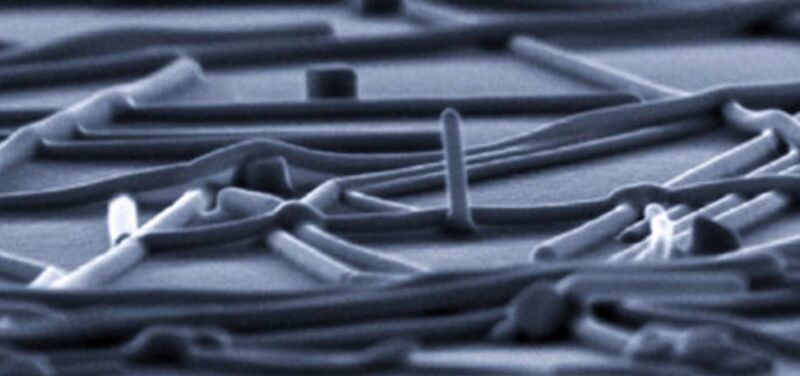
The key term in integrated circuits is integrated. The ability of fabrication facilities to integrate things sets limits on what processes are available, and what materials can be safely used. As soon as you suggest a different material or process, the whole chain is broken, and anybody suggesting it should expect people questioning your suitability for your current position. “Compatibility” is why you will not find laser-powered integrated circuits in your laptop.
The ability to make lasers using integrated-circuit-compatible materials, however, may have gotten a boost, with a demonstration of glowing (but not yet lasing) silicon.
Looking on the bright side
Optics and lasers are the backbone of high speed data transmission. You do not use copper wires to transport data at 1Tb/s. Instead you will use glass and some finely tuned and very expensive laser diodes. But laser diodes are made using processes and materials that are not compatible with those used to make integrated circuits. So, while it is possible to create, say, an optical interconnect between a RAM module and a CPU, you have to somehow glue the optics to the silicon chip in exactly the right location. Research labs are happy to sacrifice PhD students to such ventures, but PhD-bots don’t scale well, are high maintenance, and their deployment leads to dark looks.
A better solution would be to get silicon to emit light, but it really doesn’t like doing that. The reason is not that complicated, but does take a few words to explain.
Light is created by charged particles like electrons that give up energy to emit a photon. In a semiconductor, electrons cannot have just any old energy—they have to have an energy that is allowed by the structure of the material. The available electron states in semiconductors are limited, which can lead to issues. For instance, an electron might have a fair old chunk of energy, but not be able to emit it because all the lower energy states are occupied by electrons already.
The situation is even darker than that, because states are defined by more than their energy; their properties include momentum, angular momentum, and more. So, there might be a low energy state available to an electron with energy to spare, yet the electron cannot enter that state directly because it has the wrong momentum.
This is exactly the problem that electrons in silicon face. An electron can be excited and should emit a near-infrared photon to get rid of its excess energy. But, all the available low energy states require that the electron simultaneously emit a photon and change momentum (usually by bouncing off a silicon atom). Since that combination is highly unlikely, the electron just bounces around losing both energy and momentum by collisions.
Materials where electrons can't simply cross energy barriers are referred to as indirect band-gap semiconductors. In these semiconductors, very little light is emitted.
Silicon is not the only material like this. The researchers were inspired by the behavior of its close relative, germanium, which is similarly unenlightened. If the crystal structure (the way the germanium atoms are arranged) of germanium is changed, then the electrons can emit photons without having to change momentum. In other words, the band-gap changes from indirect to direct based on the material's structure.
Better together
To get silicon glowing, the researchers turned to alloys. A cool thing about semiconductors is that their optical and electronic properties tend to smoothly change when you alloy them. If you add germanium to silicon, the resulting alloy will start showing some of the characteristics of germanium. However, while some properties can be adjusted continuously, others cannot. A band-gap is either direct or indirect, not a mixture. So, how much germanium does it take to make silicon glow?
The answer turns out to be about 65 percent.
To come up with this number, researchers grew nanowires of silicon-germanium alloys. The nanowires allowed them to choose a template material that forced the silicon-germanium alloy to form the right crystalline structure to form a band-gap. It also allowed the researchers to compare different quality crystalline structures.
The researcher’s experiments put a spotlight on quality: the nanowires had to be near perfect to get a reasonable amount of light out of them. All crystals have mistakes (gaps or dislocations) in them, and high quality crystals have fewer. But, once the researchers had perfected making the nanowires, the produced ones would emit a surprisingly large amount of light.
The amount of light is low compared to mature laser diode technology, but still bright compared to what was available before. The shining silicon seems to reveal a viable route to putting all the required elements for optical communications on a silicon chip. This means that communication with peripherals like memory, hard drives, and more can be faster. It also means that things like on-chip clock synchronization is easier to organize. But, for all that to happen, the researcher’s dimly glowing wire has to burn its way onto the fab’s list of acceptable materials.
Nature, 2020, DOI: 10.1038/s41586-020-2150-y (About DOIs)
"how" - Google News
April 11, 2020 at 08:30PM
https://ift.tt/2yN8V2Q
Glowing silicon nanowire reveals how to put optics in your CPU - Ars Technica
"how" - Google News
https://ift.tt/2MfXd3I
Bagikan Berita Ini















0 Response to "Glowing silicon nanowire reveals how to put optics in your CPU - Ars Technica"
Post a Comment